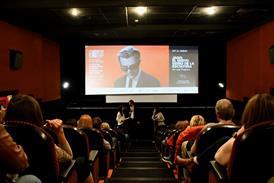The ministries behind India’s newly launch Film Facilitation Office are starting a series of workshops next month to open the dialogue between the central, state and local governments and representatives of the film industry to talk how to make India more filming-friendly.
Sunil Arora, Secretary, Ministry of I&B and Vinod Zutshi, Secretary of Tourism, were at Film Bazaar on Saturday to attend the invitation-only Film Tourism Symposium organised in partnership with NFDC (which will also organise the workshops).
The four-day symposium welcomed Indian filmmakers talk directly about their needs with government representatives as well as foreign film experts. The two ministers appeared on Saturday; Shharat Sharma, Additional Director General of the Archaeological Survey of India spoke yesterday; GK Dwivedi from the Ministry of Home Affairs will speak today; and Narenda A. Patil of the Central Railway will speak tomorrow.
Attending filmmakers said they were glad that government officials had started the FFO and were listening directly to their needs. Ramesh Sippy called the announcement of the FFO “a fine beginning. For years we’ve been talking about this, now it has been launched… If we give our feedback properly we can get some guidelines….I would like to believe that what started this week will lead to a better working of things.”
Pravash Sanhi, who has worked on international productions such as Life of Pi and Slumdog Millionaire, said: “This should definitely work, they should have a workshop with people like us who know the problems we work with.”
As Ahora said, “Instead of housing [the FFO] in a typically government set-up we decided to house it in the NFDC, which has a structure that is more flexible and procedures that hopefully should be less bureaucracy.
He said the FFO shouldn’t try to reinvent the wheel but should “adapt the best practice already present in India and abroad…We will propose to call a formal interactive session with colleagues form the states, Ministry officers, the NFDC, film directors – all will be involved. We will make sub-groups and see how we can all work together to synergise our efforts.”
Practical points
Some of the issues already raised at the Symposium are very practical points. Sanhi one example of an issue that could be addressed is shooting with drones, something that international filmmakers are obsessed with now. “We need a policy. It can take us 6 to 8 months to get aerial photography permission, in Nepal it takes 10 days.”
Shyam Benegal said, “We need a single window… You need one person who you tell where you want to shoot and they tell the local authorities. Each of us [filmmakers] have a different need, but we’ve had this continuing problem that you have to go to different authorities in different times.” He said at a local level you can even find some corrupt officials trying to extort film productions.
Anubhav Sinha added, “I’m already optimistic. Our industry is very different than a lot of other businesses. The tourism and film worlds need to sit down and understand each other a little bit. It is possible.”
Prakash Jha also said script clearances were an issue. “Having to get script read before you get permission to shoot on location doesn’t make sense,” he said, and he also asked the ASI’s Sharma to loosen requirements of reading scripts before shooting at monuments, saying that it could lead to unneccesary censorship.
But Sharma said that was not an easily changed attitude, “If our agency is facilitating this shoot for your film, we have to want to be responsible for you projecting this monument in a certain way,” for example the ASI turned down a dance scene that was to be set on top of a tomb.
Sharma got sounds of approval from the attending filmmakers when he said the ASI was “willing to look at the angles” that filmmakers need for easier film shoots at monuments, at everything from the Taj Mahal to a simple roadside shrine. “Some of our policies are already under review,” he noted, and he took notes on specific suggestions from filmmakers, such as being open for early morning set up at iconic locations to allow for shooting at sunrise. As Sanhi noted, “Directors say best moment for a sunrise or sunset, it’s that magic moment. If we can get in two hours before sunrise, that would be a great help.”
Sharma also said the AIS, which looks after 3,686 monuments, would plan to offer a list of local permissions needed, monument by monument.







![The Brightest SunScreen[Courtesy HKIFF]](https://d1nslcd7m2225b.cloudfront.net/Pictures/274x183/3/5/0/1448350_thebrightestsunscreencourtesyhkiff_312678.jpg)











![[Clockwise from top left:] Francois Ozon, Benjamin Voisin, Swann Arlaud, Pierre Lottin, Rebecca Marder, Denis Lavant](https://d1nslcd7m2225b.cloudfront.net/Pictures/100x67/1/0/6/1449106_thestrangerv2_631475.jpg)





No comments yet